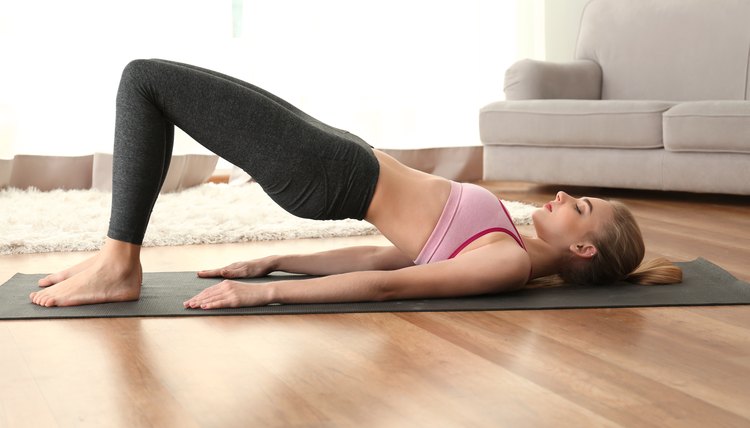Leg Cramps While Lying and Stretching

Leg cramps are involuntary, painful muscle contractions that come on fast, make it hard to walk or run, or instantly wake you from a peaceful slumber. Leg cramps are most often felt in the calf and sometimes referred to as a charley horse.
Most people have experienced at least one muscle cramp in their lifetime and are often felt with increasing age and with athletes. While some leg cramps are medically related, most are harmless and last only a few minutes. In most cases, they are related to preventable and treatable causes, such as dehydration and electrolyte imbalances, according to the Mayo Clinic.
Leg Cramping at Night
Painful leg cramping at night is considered to be a nocturnal leg cramp. Nocturnal leg cramping effects 6 percent of the population, according to the National Center for Biotechnology Information, but 33 percent of adults over 50 years old, according to research published in BMC Family Practice. The prevalence of nocturnal leg cramping at night while lying increases with age and is thought to be caused by the muscle shortening due to decreased physical activity
What Causes Leg Cramps?
There are many reasons for leg cramps, depending on the type of activity associated with the time of the cramp. For nocturnal leg cramps, the authors published in BMC Family Practice indicate the medical reasons for the cramps include dehydration, magnesium or calcium deficiencies, varicose veins, or vascular diseases. Pregnancy is also a risk factor for leg cramps, although the reason for these is unclear. During physical activity, heat is most often the cause for leg cramping, most often due to dehydration and electrolyte imbalances.
Can Stretching Cause Leg Cramps?
Stretching is rarely a cause for leg cramps, but holding a stretch for too long can trigger a cramp. When participating in any physical activity, it may be helpful to stretch prior, to help lengthen the muscle. The Mayo Clinic suggests stretching before bedtime, or even riding a stationary bike for a few minutes to improve blood flow to prevent the painful contractions.
Remedy for Active Leg Cramp
When a leg cramp comes on, the first reaction is to grab the affected leg. The Cleveland Clinic suggests forcefully stretching the affected muscle. Also walking around, jiggling the muscle, and massaging the muscle may be helpful — and note there may be a knot where the cramp originated. A warm bath or shower or a warm compress can help when the muscle is tight and an ice pack can help when the muscle is sore.
Prevention for Leg Cramps
The best defense against leg cramps, day and night, is to stay hydrated. Depending on your level of physical activity and the season, you may need more or less water to keep your muscles from cramping. If exercising in the heat for an extended period of time, drinking a fluid with electrolytes can reduce your risk of leg cramps, according to the U.S. National Library of Medicine. These types of drinks can help prevent electrolyte imbalances from excessive sweating.
When to See A Doctor for Leg Cramps
If your muscle cramps are followed by muscle weakness, redness, or swelling, seek medical attention. If they are becoming more frequent, more painful, and don't resolve after a few minutes, make an appointment with your doctor.
If you are concerned about your leg cramps or nocturnal legs cramps being caused by an underlying medical condition or medication you may currently be taking, speak with your primary physician. In addition, never take individual vitamin supplements for leg cramps unless instructed by your medical team. These may interact with current medications and not treat your symptoms properly.
References
- NCBI: Muscle Cramps
- BMC Family Practice: Criteria in diagnosing nocturnal leg cramps
- Mayo Clinic: Cramps - Symptoms and Causes
- Cleveland Clinic: Leg Cramps at Night Management
- U.S. National Library of Medicine - MedLine Plus: Spasms
- Young G. Leg cramps. BMJ Clin Evid. 2015;2015
- Jahic D, Begic E. Exercise-associated muscle cramp-doubts about the cause. Mater Sociomed. 2018;30(1):67-69. doi:10.5455/msm.2018.30.67-69
- Waters TR, Dick RB. Evidence of health risks associated with prolonged standing at work and intervention effectiveness. Rehabil Nurs. 2015;40(3):148-65. doi:10.1002/rnj.166
- Skogar O, Lokk J. Pain management in patients with Parkinson's disease: challenges and solutions. J Multidiscip Healthc. 2016;9:469-479. doi:10.2147/JMDH.S105857
- Hallegraeff J, De greef M, Krijnen W, Van der schans C. Criteria in diagnosing nocturnal leg cramps: a systematic review. BMC Fam Pract. 2017;18(1):29. doi: 10.1186/s12875-017-0600-x
- Mcdermott MM. Lower extremity manifestations of peripheral artery disease: the pathophysiologic and functional implications of leg ischemia. Circ Res. 2015;116(9):1540-50. doi:10.1161/CIRCRESAHA.114.303517
- Blyton F, Chuter V, Walter KE, Burns J. Non-drug Therapies For Lower Limb Muscle Cramps. Cochrane Database Syst Rev 2012; 1:CD008496.
- Grandner MA, Winkelman JW. Nocturnal leg cramps: Prevalence And Associations With Demographics, Sleep Disturbance Symptoms, Medical Conditions, And Cardiometabolic Risk Factors. PLoS One 2017; 12:e0178465.
- Allen RE, Kirby KA. Nocturnal Leg Cramps. Am Fam Physician 2012; 86:350
- American Academy of Sleep Medicine. Sleep Related Leg Cramps. In: International Classification of Sleep Disorders, 3rd ed., American Academy of Sleep Medicine, Darien, IL 2014. p.299-303.
- Maquirriain J, Merello M. The Athlete with Muscular Cramps: Clinical Approach. J Am Acad Orthop Surg 2007; 15:425.
Writer Bio
Sarah Pflugradt holds a Master of Science in food science and human nutrition from Colorado State University. Pflugradt is a freelance writer and registered dietitian with experience in clinical nutrition and outpatient counseling for diabetes management and weight loss.
